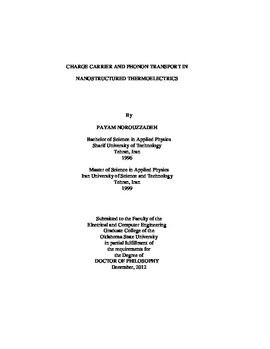| dc.contributor.advisor | Vashaee, Daryoosh | |
| dc.contributor.author | Norouzzadeh, Payam | |
| dc.date.accessioned | 2013-12-10T18:12:53Z | |
| dc.date.available | 2013-12-10T18:12:53Z | |
| dc.date.issued | 2012-12 | |
| dc.identifier.uri | https://hdl.handle.net/11244/7888 | |
| dc.description.abstract | There is currently no quantum mechanical transport model for charge (or phonon) transport in multiphase nano-crystalline structures. Due to absence of periodicity, one cannot apply any of the elegant theorems, such as Bloch's theorem, which are implicit in the basic theory of crystalline solids. Atomistic models such as Kubo and NEGF may assume an accurate knowledge of the interatomic potentials; however, calculations for real 3D random multi-phase systems require so large computational times that makes them practically impossible. In a multi-phase nano-crystalline material, grains and interfacial microstructures may have three distinct types as depicted in figure. In such a material, the physical processes in each individual grain no longer follow the well described classical continuum linear transport theory. Therefore, a proper model for coupled transport of charge carriers and phonons that takes into account the effect of their non-equilibrium energy distribution is highly desirable. | |
| dc.description.abstract | Two new theories and associated codes based on Coherent Potential Approximation (CPA) one for electron transport and one for phonon transport are developed. The codes calculate the charge and phonon transport parameters in nanocomposite structures. These can be nano-crystalline (symmetric case) or the material with embedded nano-particles (dispersion case). CPA specifically considers multi-scattering effect that cannot be explained with other semi-classical methods such as Partial Wave or Fermi's golden rule. To our knowledge this is the first CPA code developed to study both charge and phonon transport in nanocomposite structures. The codes can be extend to different types of nano-crystalline materials taking into account the average grain size, as well as the grain size distribution, and volume fraction of the different constituents in the materials. This is a strong tool that can describe more complex systems such as nano-crystals with randomly oriented grains with predictive power for the properties of electrical and thermal properties of disordered nano-crystalline electronic materials. | |
| dc.format | application/pdf | |
| dc.language | en_US | |
| dc.rights | Copyright is held by the author who has granted the Oklahoma State University Library the non-exclusive right to share this material in its institutional repository. Contact Digital Library Services at lib-dls@okstate.edu or 405-744-9161 for the permission policy on the use, reproduction or distribution of this material. | |
| dc.title | Charge carrier and phonon transport in nanostructured thermoelectrics | |
| dc.contributor.committeeMember | Krasinski, Jerzy | |
| dc.contributor.committeeMember | Acken, John Michael | |
| dc.contributor.committeeMember | Ede, Kenneth F. | |
| osu.filename | Norouzzadeh_okstate_0664D_12509.pdf | |
| osu.accesstype | Open Access | |
| dc.type.genre | Dissertation | |
| dc.type.material | Text | |
| dc.subject.keywords | charge transport | |
| dc.subject.keywords | coherent potential approximation | |
| dc.subject.keywords | nanostructuring | |
| dc.subject.keywords | phonon transport | |
| dc.subject.keywords | thermoelectrics | |
| thesis.degree.discipline | Materials Science and Engineering | |
| thesis.degree.grantor | Oklahoma State University | |
